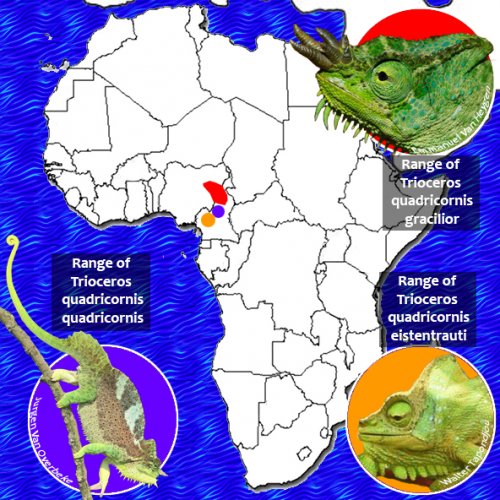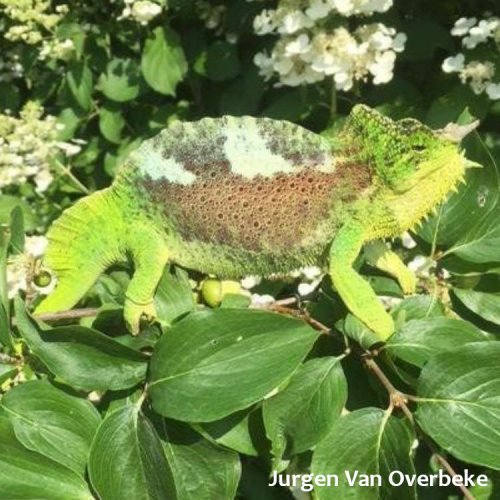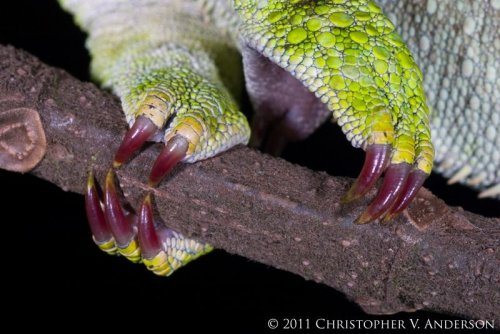Natural History of Trioceros quadricornis
Welcome to this World Species entry by Bill Strand and featuring the breeding insight of Jurgen Van Overbeke! We are still in Cameroon, but we are moving up in elevation. It seems like Cameroon likes its horned chameleons because the next species is the Trioceros quadricornis, or the four-horned chameleon. According to the IUCN Red List these chameleon can be found from 1150 to 2400m a.s.l. There are three subspecies, T. quadricornis quadricornis, T. quadricornis gracilior, and T. quadricornis eisentrauti. T. q. quadricornis is the most commonly seen, but gracilior is not uncommon. T. q. eisentrauti, on the other hand, is unknown (to my knowledge) to be in captive collections. Even images of T. q. eisentrauti are difficult to find!
The males of the two subspecies we do see in the trade, T. q. quadricornis and T. q. gracilior, are characterized by four to six short, upturned horns on the rostral region. Females do not, generally, have horns. A small percentage of females will grow horns seemingly to spite our efforts to be able to say we know something.
Trioceros quadricornis gracilior will sport some dramatically red claws and a larger set of horns. But their sail fins are not as pronounced as in T. q. quadricornis.



Male Triceros quadricornis quadricornis
 [AT
[AT

Male Trioceros quadricornis gracilior

Male Trioceros quadricromia eisentrauti


Gravid female Trioceros quadricornis quadricornis and juvenile hatched by Jurgen
Captive Husbandry and Breeding
You will find that care for T. quadricornis is very similar with most of the chameleons from Cameroon. They require cool temperatures and high humidity. But, let’s bring Jurgen on!
“Both Trioceros quadricornis quadricornis and T. q. gracilior range within Cameroon, T. q. gracilior also is present in Nigeria. The male and females are about the same size as males and females of panther chameleon.
“Quads”, as they are known, need a large, well planted terrarium. Although they do eventually get used to humans, they will appreciate a place where they could hide away from the steady stream of people outside its cage. I keep them outside when the weather permits. Quads are known to bask if the mornings are cool.
Quads are not tolerant of other chameleons- especially the males- and should be kept individually.
Quads will appreciate a variety in food items. I dust with a calcium powder and every two weeks I add vitamin D3 to the supplementation.
Don’t give too much synthetic vitamins because of edema sensitivity. They are relatively large when they come from the egg and T. q. quadricornis can be sexed from hatching with about 90% confidence by a sail fin on the tail. Unfortunately, females can have a sail fin 10% of the time so this method is not absolute. T. q. gracilior is much more difficult as the females have the same tail fin at the males and so you must wait for five or so months until the horns start to grow in the males. Though this is, once again, only 90% effective as sometimes female gracilior will have horns as well. They do not grow as large as the horns of the male, but at that young age it can cause confusion in sexing the chameleons.
Gestation for the females is 2 to 3 months. In the summer when it is warmer gestation is more towards the two month mark. This is the same between T. q. quadricornis and T. q. gracilior. Incubation of the eggs depends on temperature. A warmer incubation (21-22C or 69-72F) results in an incubation of about 5.5 months while a cooler incubation (18-19C or 64-66F) extends to 7 months.
Trioceros quadricornis has been a fascinating species to explore and is easy to reproduce. It is a solid animal and one of my favorites."
Welcome to this World Species entry by Bill Strand and featuring the breeding insight of Jurgen Van Overbeke! We are still in Cameroon, but we are moving up in elevation. It seems like Cameroon likes its horned chameleons because the next species is the Trioceros quadricornis, or the four-horned chameleon. According to the IUCN Red List these chameleon can be found from 1150 to 2400m a.s.l. There are three subspecies, T. quadricornis quadricornis, T. quadricornis gracilior, and T. quadricornis eisentrauti. T. q. quadricornis is the most commonly seen, but gracilior is not uncommon. T. q. eisentrauti, on the other hand, is unknown (to my knowledge) to be in captive collections. Even images of T. q. eisentrauti are difficult to find!
The males of the two subspecies we do see in the trade, T. q. quadricornis and T. q. gracilior, are characterized by four to six short, upturned horns on the rostral region. Females do not, generally, have horns. A small percentage of females will grow horns seemingly to spite our efforts to be able to say we know something.
Trioceros quadricornis gracilior will sport some dramatically red claws and a larger set of horns. But their sail fins are not as pronounced as in T. q. quadricornis.
Male Triceros quadricornis quadricornis
Male Trioceros quadricornis gracilior
Male Trioceros quadricromia eisentrauti
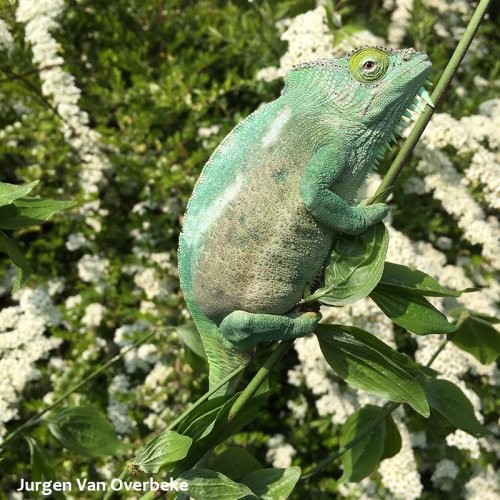
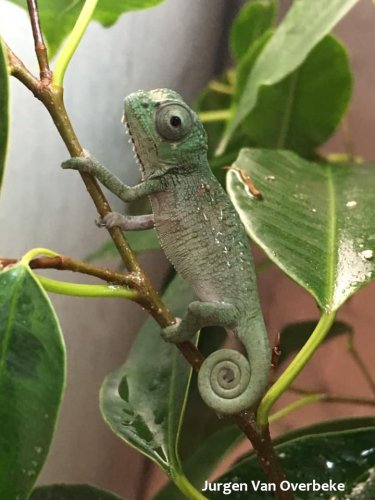
Gravid female Trioceros quadricornis quadricornis and juvenile hatched by Jurgen
Captive Husbandry and Breeding
You will find that care for T. quadricornis is very similar with most of the chameleons from Cameroon. They require cool temperatures and high humidity. But, let’s bring Jurgen on!
“Both Trioceros quadricornis quadricornis and T. q. gracilior range within Cameroon, T. q. gracilior also is present in Nigeria. The male and females are about the same size as males and females of panther chameleon.
“Quads”, as they are known, need a large, well planted terrarium. Although they do eventually get used to humans, they will appreciate a place where they could hide away from the steady stream of people outside its cage. I keep them outside when the weather permits. Quads are known to bask if the mornings are cool.
Quads are not tolerant of other chameleons- especially the males- and should be kept individually.
Quads will appreciate a variety in food items. I dust with a calcium powder and every two weeks I add vitamin D3 to the supplementation.
Don’t give too much synthetic vitamins because of edema sensitivity. They are relatively large when they come from the egg and T. q. quadricornis can be sexed from hatching with about 90% confidence by a sail fin on the tail. Unfortunately, females can have a sail fin 10% of the time so this method is not absolute. T. q. gracilior is much more difficult as the females have the same tail fin at the males and so you must wait for five or so months until the horns start to grow in the males. Though this is, once again, only 90% effective as sometimes female gracilior will have horns as well. They do not grow as large as the horns of the male, but at that young age it can cause confusion in sexing the chameleons.
Gestation for the females is 2 to 3 months. In the summer when it is warmer gestation is more towards the two month mark. This is the same between T. q. quadricornis and T. q. gracilior. Incubation of the eggs depends on temperature. A warmer incubation (21-22C or 69-72F) results in an incubation of about 5.5 months while a cooler incubation (18-19C or 64-66F) extends to 7 months.
Trioceros quadricornis has been a fascinating species to explore and is easy to reproduce. It is a solid animal and one of my favorites."

